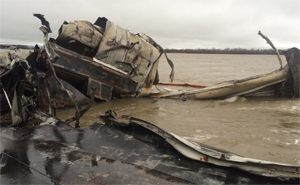Up to 25,000 gallons of clarified slurry oil leaked into the Mississippi River after a barge struck a pier near Natchez, Miss.
The 3,800-hp towboat M/V Amy Frances was pushing six barges downriver when the lead barge MM-46 hit a pier at the Natchez-Vidalia Bridge, said Lt. j.g. Rita Walter of Coast Guard Sector Lower Mississippi. Five barges broke away, and MM-46 partially sank at mile marker 363, just south of the bridge.
The incident, reported at 1302 on Jan. 21, was among more than a dozen bridge strikes, breakaways and other incidents over a period of weeks when the river was above flood stage. The Coast Guard declined to comment on a potential cause of the Natchez accident.
Magnolia Marine Transport of Vicksburg, Miss., operates Amy Frances and MM-46. The company did not respond to phone messages seeking comment on the accident.
Four of the six barges Amy Frances was pushing contained clarified slurry oil and the other two were empty. MM-46 sustained heavy damage after hitting the bridge pier and began leaking oil into the river.
“Damage to barge MM-46 includes breach of bow void and damage to the No. 1 port cargo tank,” Walter said in an email.
Salvage efforts began the day after the accident, and on Jan. 23 workers began moving oil from MM-46 into a receiver barge with help from towing vessel Kathy Azlin plus Amy Frances. Federal and state agencies established a unified command to oversee the response. MM-46 was raised Jan. 25 and towed to Vicksburg for repairs.
 |
|
The towing vessels Kathy Azlin and Amy Frances conduct lightering operations. |
|
Courtesy U.S. Coast Guard |
Barge MM-46 can carry as much as 24,000 barrels, and a National Oceanic and Atmospheric Administration (NOAA) incident report said its entire capacity was “at risk” of spilling into the river. The barge was built in 1992 and is based in New Orleans, according to Magnolia Marine’s website.
In late January, the Coast Guard said only about 25,000 gallons of oil, or about 590 barrels, were “unaccounted for” after lightering operations. Walter said it’s not clear how much oil reached the river.
Slurry oil is a byproduct of refining that is heavier than water. Officials initially spotted a sheen in the river. High water and the fast current hampered underwater recovery efforts. NOAA used side-scanning sonar to search for the oil but did not locate any, the Coast Guard said.
“The river receding has allowed for contractors to assess the shoreline and remove any left-behind product,” Walter said, adding that those operations were continuing.
The Mississippi Department of Transportation operates the Natchez bridge, which carries U.S. Highway 84 traffic over the Mississippi River between Louisiana and Mississippi. The agency inspected the bridge and determined that it did not sustain structural damage, spokesman Michael Flood said.
Authorities imposed various restrictions on the Mississippi from mile marker 363 to 438 between Jan. 21 and 25 during salvage and oil response operations. Those restrictions were lifted on Jan. 25.

